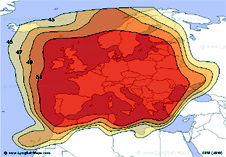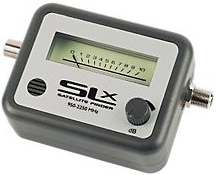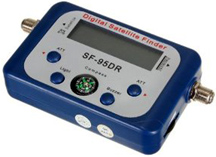Tuesday 31 March, 2015, 04:51 - Radio Randomness, Satellites, Much Ado About Nothing
Posted by Administrator
It's been a long while since anyone at Wireless Waffle installed any satellite dishes, however as part of a project to improve language skills, it was decided that the WW HQ would be fitted with the kit needed to receive German television. This is the sad story of the trials and tribulations of what should have been a simple job in the hope that it may help others trying the same thing not to fall into the same traps that befell our attempts!Posted by Administrator
Firstly, a visit to Lyngsat and a browse through the dozens of satellites that cover Europe quickly yielded the fact that the channels that were wanted could be found on various Astra 1 satellites at an orbital position of 19.2 degrees East (19.2E). As a ready reckoner, the following orbital positions are the 'hot-slots' for various European languages:
- English - 28.2E
- French - 5W
- German - 19.2E
- Italian - 5W or 13E
- Polish - 13E
 The next thing to do is find out what size of dish is needed to receive the satellite that's of interest. This is more complex as it requires a knowledge of the satellite's footprint and the strength of signal at a particular location. For 19.2E in the UK, even a 55cm dish should be fine pretty much everywhere, so a Triax 54cm dish was duly purchased together with a suitable wall bracket and an Inverto LNB.
The next thing to do is find out what size of dish is needed to receive the satellite that's of interest. This is more complex as it requires a knowledge of the satellite's footprint and the strength of signal at a particular location. For 19.2E in the UK, even a 55cm dish should be fine pretty much everywhere, so a Triax 54cm dish was duly purchased together with a suitable wall bracket and an Inverto LNB.The mounting of the dish on the wall was relatively straightforward, having made sure that there were no obstructions in the line-of-sight from the dish to the satellite (such as trees or other buildings). With the dish on the wall, the next step is to align it so that it is pointing at the satellite. In general a rough idea of the right direction can be gathered if you know your latitude and longitude and the satellite you wish to receive through many online tools (such as dishpointer.com).
Getting the dish pointing in roughly the right direction is not too difficult, but even a small dish needs to be pointing with an accuracy of better than plus or minus 1 degree (bigger dishes have to be even more accurately aligned) and so some form of fine tuning is needed.
In analogue days gone past, by far the best way to align a dish was to connect it to a satellite receiver, and connect the satellite receiver to a television, and put the whole lot in a place where the TV could be seen from the dish. With the satellite receiver tuned to a channel on the appropriate satellite, it was then just a matter of moving the dish about until a signal could be seen on the TV. Once the signal was found, gently moving the dish from side-to-side and up-and-down to a point where the quality of the picture was maximised was all that was needed. Of course the same method can still be used today, but there has to be a less crude way, right? Right...
 The SLX Satellite Finder costs less than a few metres of CT-100 coax, and provides both a visual indication of signal strength (using the in-built meter) and an audible indication (using the in-built buzzer). All that is then required to use this to align a dish is a 'patch lead' so that the dish can be connected to a socket on the meter and then a lead coming from the (indoor) satellite receiver connected to the other socket on the meter to supply power. So far, so good.
The SLX Satellite Finder costs less than a few metres of CT-100 coax, and provides both a visual indication of signal strength (using the in-built meter) and an audible indication (using the in-built buzzer). All that is then required to use this to align a dish is a 'patch lead' so that the dish can be connected to a socket on the meter and then a lead coming from the (indoor) satellite receiver connected to the other socket on the meter to supply power. So far, so good.Now, turn on the satellite receiver and return to the dish. In theory, the meter should only register a signal if the dish is pointing at a satellite. However, the modern Inverto LNB was obviously doing a far better job of receiving than the systems that the crusty SLX meter was being designed to work with resulting in a full-scale meter deflection (and an annoying beep that could not be turned off) almost regardless of the position of the dish. No amount of experimentation yielded anything other than full-strength or nothing, and the full-strength indication happened across a wide arc of the sky and with the elevation angle of the dish anything within 10 degrees of that which should have been right. In a word, beeping useless!
 Not to be defeated, and rather than cart the TV and receiver outdoors, a second, seemingly more modern meter was purchased, the SF-95DR Satellite Finder. This proved to be marginally better, but having the dish within 'a few' degrees of the right position still yielded a full-scale signal. At least the beep could be turned off.
Not to be defeated, and rather than cart the TV and receiver outdoors, a second, seemingly more modern meter was purchased, the SF-95DR Satellite Finder. This proved to be marginally better, but having the dish within 'a few' degrees of the right position still yielded a full-scale signal. At least the beep could be turned off.An old trick from the analogue days to reduce the signal to make fine tuning the position of the dish easier if the signal was very strong, was to cover the dish in a damp tea-towel. The water in the towel will attenuate the signal making the signal weaker and thus the dish easier to align. This trick was tried using the SF-95DR but alas, only resulted in the need to keep picking up a damp tea-towel from the floor, every time the wind blew it off.
Eventually, more through luck than skill, a point was found where the meter indicated a peak that was within a degree or so of nothingness in nearby directions, suggesting that the dish was aligned to a satellite. An excited scan of the receiver revealed some signals but alas, from the wrong satellite (13 East instead of 19.2 East). Of course the meter would no more know which satellite it was pointing at than an amoeba would know the difference between a car and a lorry, just that both seem pretty big. More fiddling, and a slightly damper tea-towel and a second 'peak' was found. Another tune of the receiver and 'Allelujah!' channels that were being transmitted from 19.2 East were found. But only from one transponder...
 What could this mean? Was it that the dish was roughly aligned but that only the very strongest signal was being received? Was it that the LNB was faulty? Was there a fault in the cable from the dish to the receiver indoors? Any (or all) of these could be the problem and with nothing more to go on, it seemed that the only way to resolve the issue was to resort to carting the TV and receiver outdoors so that the screen could be seen from the location of the dish. Doing this would mean that the 'signal strength' and 'quality' bars on the receiver's on-screen menu display could be used to point the dish more accurately.
What could this mean? Was it that the dish was roughly aligned but that only the very strongest signal was being received? Was it that the LNB was faulty? Was there a fault in the cable from the dish to the receiver indoors? Any (or all) of these could be the problem and with nothing more to go on, it seemed that the only way to resolve the issue was to resort to carting the TV and receiver outdoors so that the screen could be seen from the location of the dish. Doing this would mean that the 'signal strength' and 'quality' bars on the receiver's on-screen menu display could be used to point the dish more accurately.A new patch lead from the dish to the receiver was fitted with F-connectors (thereby ruling out any problem with the coax feeding indoors). Power up... And the receiver is showing 100% signal strength (very good!) but a signal quality of only 60% (OK but not brilliant). No amount of dish repositioning would yield any improvement and still just the one transponder was receiveable. Before giving up and ordering a new LNB, and with an increasing level of suspicion building up, the meter was taken out of line so that the dish was connected directly to the receiver without the meter in circuit.
Hey presto...! Now the receiver was showing 100% signal and 80% quality and, wait for it, all of the transponders on the satellite could be received. A final fine-tune of the dish position and the quality of reception was increased to 90% - not a bad result at all. Moving the TV and receiver back indoors to the other end of the original run of coax and this excellent result was maintained. It seems that the meter may have been overloaded by the signal from the satellite and was somehow distorting the signal (possibly it was generating harmonics or intermodulation products).
So the lessons from this cautionary tale are:
- Don't use cheap 'satellite finder' meters to help align dishes, they cause more problems than they solve.
- Stick to the tried and tested methods and just move a TV and receiver to a place where they can be seen from the dish and use the receiver's signal meter for alignment.
- Damp tea-towels should be used for wiping down surfaces in kitchens and not for the setting-up of sensitive electronic equipment.
At this point you're probably thinking that this is the end of this cautionary tale, but you'd be wrong... there's more to come! Stay tuned to Wireless Waffle for our next extremely uninspiring episode of: HOW NOT TO INSTALL A DISH.
1 comment
( 1051 views )
| permalink
| 



 ( 2.9 / 8418 )
( 2.9 / 8418 )




 ( 2.9 / 8418 )
( 2.9 / 8418 )

